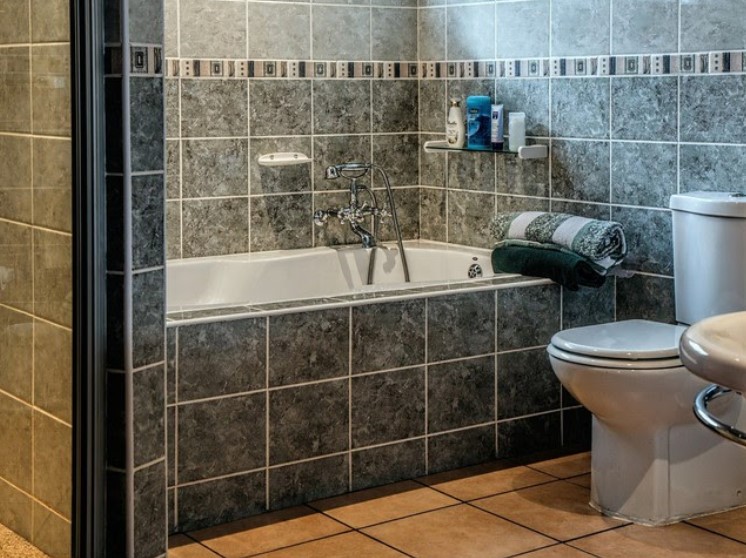
The grout between tiles can make the difference between looking dingy or dazzling. Grout is porous and can absorb grease, oil, or other spills. While the cause of the problem may be different from one room to the next (mildew in a bathroom, cooking splatters on the kitchen floor, mud stains in the foyer floor), it doesn’t require specialised systems to clean the grout and surrounding tiles. This is a foolproof way to make your floor and wall tiles shine.
Clean the Tiles
A DIY grout cleaner made of warm water and dish soap is suitable for most tile types, including ceramic and porcelain. Although vinegar is highly acidic, dilute vinegar is a good option. You can damage grout if the solution is too strong. Vinegar can also etch stones tiles. Spray the solution with water and dish soap. Then wipe it off with a microfiber towel or cloth.
Use steam to scrub bathroom tiles.
You’ll likely be dealing with not just surface dirt and debris but also soap scum residue. This can be difficult to get rid of. You can make it easier by spraying the tiles and walls with surface cleaner. Then, heat the water for five minutes to create steam. After waiting 20 minutes, the tiles will be easier to clean with a cloth.
Clean the Grout Lines
It’s time to pay attention to grout lines between the tiles. The grout’s composition can determine how grimy it gets. Traditional grout is made from cement and sand, but there are more modern options such as latex or other polymers that will improve their stain resistance. Water and patience are your best tools, no matter what stain you have.
To remove any dirt and grime, spray the grout with hot water. A steam cleaner is a great option. Use your steamer to apply to grout. Next, use the brush to scrub the grout in a circular motion. You can wipe off any excess moisture with a rag. The grout may then look as good as new once it dries.
Why Water Works The Best
Water is safe and gentle for grout because it has a neutral pH (7). This is not true for highly acidic cleaners like vinegar (a pH of about 2) or bleach (a pH of approximately 12), so it’s best to avoid using them.
Pay More Attention to Stubborn Grout Stains
Grab a pH neutral cleaner if your grout looks still dull. Next, grab a stiff brush and scrub it again. The most important ingredient is elbow grease. The Magic Eraser can also be used to remove stubborn stains quickly, but you may need to use more than one professional tile and grout cleaner to make a room sparkle. To remove any grout cleaner, use a microfiber cloth or sponge to scrub the tiles. Make sure to use a clean, dry cloth with fresh water. The grout can quickly absorb dirt and stains if it’s rinsed with a dingy mop. “
Alkaline cleaners such as Mr Clean, Spic and Spike or Span are good options for stubborn stains. Perform a quick test on a small area of any non-neutral cleaner. You should wait a while to ensure that you don’t see any discolouration or damage before proceeding to the next grout line.
Kill Mould
Bathrooms with restricted circulation and high humidity are ideal environments for mould spores. Although bleach can kill mould on non-porous surfaces such as countertops and tiles, it is not effective on porous surfaces such as grout, caulk, drywall and wood. To lower humidity, make it a habit of opening a window after showers or running the bathroom fan.
Seal Your Success
Sealers seal grout pores to prevent dirt, grit and mould from entering the porous material. The frequency at which grout needs to be sealed varies depending on the traffic in the area. However, for most areas of the house, at least once a year is an acceptable goal. It is important to wait for at least 24hrs between deep-scrubbing the grout and to apply the sealer to ensure that the grout is dry completely.
Make Some Tweaks
If you notice areas that are especially grimy, such as near the laundry basket or the back door, then consider laying a rug. This will help protect your tiles floors from dirt and debris.
Bathroom Maintenance
You can cut down on grout-scouring time in the bathroom by at least half. A microfiber cloth or small squeegee can be kept near the shower to quickly clean the tiles after the water has been turned off. You won’t need to clean the tiles too much, as there isn’t any buildup on their surface. Your family should open a window and run the exhaust fan for 10-15 to 20 minutes following a shower. This will quickly remove moisture and humidity from the room and prevent mould growth.

